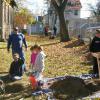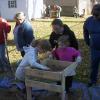Bristol Youth are DIGGIN’ It!
by Cate Murway
“If you want to understand today, you have to search yesterday.”
Pearl Sydenstricker Buck [1892-1973], American writer and novelist
Historic Bristol on the Delaware may be a small town but it is one with some very cool tall tales, filled with fascinating stories and fun tidbits of information. The beautifully maintained architecture throughout the town has a soul and an identity.
The Bristol youth have taken a go at screening some soil behind the Bristol Cultural & Historical Foundation building located at 321 Cedar Street to find treasures and clues about the Borough history because history is about so much more than just names and dates.
The students are literally “diggin’ it” and the excited young participants gathered around the screens to sift through the excavated soil. Each layer may have its own story to tell. The students just may leave with a deeper respect for the sacrifices and struggles of those before them as they learn more about the traditions and heritage and more about Bristol from the ground up!
The BCHF building was once home to a one-room Quaker School built in 1874, where the Quakers held school until about 1900. And, according to historian/ author Harold D. Mitchener, “There have been several groups that had meetings there. It once served as a place where the GAZETTE, a town paper was printed. That was before the Bristol Courier Newspaper. It served as a meeting place for the Bracken Post Legion until they moved to Radcliffe Street, opposite the Grundy Library. Several other groups met there, including The Eastern Star ladies group and also the Rainbow Girls, sponsored by the Eastern Star.
The group was home to the Bristol Seniors Travel Club of Bristol and they sold it to BCHF in 1991.”
The 1681 date on the special plaque on the BCHF building is the date of the town, not the date of the building.
Archeology is tons of dirt-digging, story-telling, mystery-solving fun and the Bristol youth were eager to figure out stories from clues and learn about the past.
The second part of the scheduled dig was held on Sunday, the 13th of November, under the educated guidance of lead archaeologist, Jesse Walker. There are many ways to find a site but Jesse and his colleagues had chosen this particular archaeological dig location in downtown historic Bristol following his "Archaeology of Bristol and Beyond" presentation at a BCHF membership meeting. Jesse worked out the “soil searching” details with the BCHF VP, Dr. Deborah Pinney from the Perelman School of Medicine, University of PA.
Archeologists are anthropologists, meaning they study people and they look at old things and sites to investigate how people lived and worked in the past.
Bristol resident, Meagan Ratini is an adjunct professor of historical preservation at Bucks County Community College where she teaches archeology. The multi-talented Meaghan is also an accomplished musician, playing the fiddle, Irish flute, and the tin whistle with the River Drivers. But being an archeologist “is my day job. This is the second part of the same dig. There are multi- generational students and volunteers from BCCC’s historic preservation team here along with Jesse and me.”
Artifacts were found representing history of the school while other salvaged pieces remained from the print shop after the building was a school. “We have found pieces of the printer’s type with the number 12 on it.”
By the 1850’s the town's first newspaper, the Bristol Gazette, published by William Bache, a great grandson of Benjamin Franklin, was the first periodical published in Bristol with a view to permanency.
The archaeologists had searched for certain landscape features on the property using maps.
“The dig locations were not always random.”
Clad in comfortable clothes and boots or sturdy shoes, the field crew school students were encouraged to play in the dirt! They unearthed fragments of colored glass, brick, and ceramics and possible typesets from that old Bucks County Gazette newspaper, amassing evidence that the newspaper operated in this building in the early 1900’s. Putting together a story from archeology is like doing a big puzzle without the box lid. Artifacts are some of the pieces, but only part of the total picture. The sharp eyes of the students were very good at spotting even tiny artifacts and they experienced the dynamic thrill of discovering them.
A real, live, in-progress mini-excavation alongside professionals is an opportunity to dig just a little deeper and see a different side of the history of this riverfront town. Digs involve lots of work and lots of fun, engaging students’ minds as well as their hands. It's the only way to learn about practical archaeology. History rocks!
First the students scanned the soil and then the dirt diggers, history seekers, and artifact lookers started their work. The most common digging tools are picks, shovels, and trowels.
Jacob was there with his dad. “I am looking at parts of artifacts that we uncovered by screening them.” He had also found some pieces of pottery and some coins.
Fifth grader Joey was at the dig with his mom. “I found coal and some rocks.”
Sophia is in the 6th grade and her finds included “glass and pottery and old coins”.
Daniel is also in the6th grade and he enjoyed “digging things up out of the ground”.
Nathan is a 7th grade student from Lancaster. “I am really into archaeology!”
Several "lay archaeologist" adults gathered as spectators and audience and participants as well.
Laura, a friend of the archaeologists, resides in Fairless Hills. She had always appreciated archaeology. “I lived in farmlands in NJ by Mercer County Park where we found arrowheads and fossils and bottles with no lids.”
Actually, digging up the past is often the easiest job in the process. Amoi was in charge of the washing duty, “not much digging”. Her tray held pieces of a smoking pipe, a bone, metal, and some glass.
Most artifacts can tolerate washing in water with the high tech tool called a toothbrush, used to remove any adhering soils.
So, everyone was invited to learn how to dig, sieve, process a find and be taught just a little of how to document material resources from the past, squeezing tangible links of at least a hundred years into one session.
Even the youngest budding archeologists showed excitement when they found shards of glass and bits of pottery or remains of animal bones. Finding fragments of daily life, or things that were once used, gives a glimpse into how people lived, and it may make people today feel just a bit more connected to past communities and those who once resided in this ‘rich in history’ town in a different time.
It’s amazing how even miniscule fragmented objects from long ago can reveal important aspects of industries that once defined the neighborhood and speak to tell a story about those who lived and passed through historic Bristol long ago.
Has this program been successful?
Former elementary school teacher, Jeanette A. “Jan” Ruano, the BCHF President for almost a year, assumed the position from Gerald J. “Gerry” McCarry, who passed away suddenly last July. Jan voiced enthusiasm and expressed her pleasure in “bringing in youth, engaging younger generations and adding another dimension to who we are here. At the first dig, they uncovered at least a foot layer of ash dirt perhaps from the coal when the building was heated.”
This activity is an organized FUN and comprehensive framework for historical interpretation through the very layers of history. Community “digs” give a greater appreciation for historic Bristol from the ground up. Tools down! Interest up.
Recommend a “Spotlight”. E-mail vjmrun@yahoo.com
click on thumbnails to enlarge



